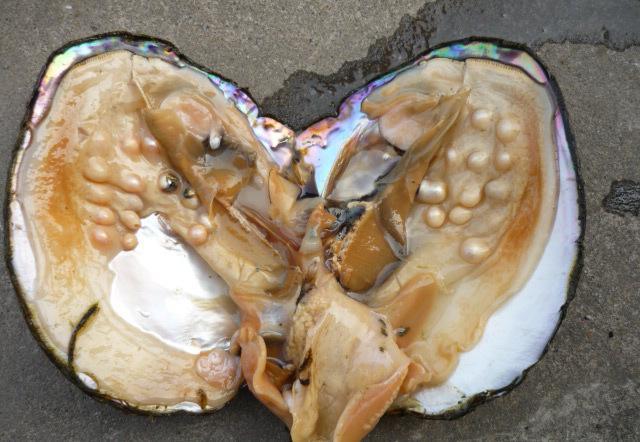Pearl oysters, mollusk phylum, vallomeria, heterozylopoda, a general term for pearl oysters. The two shells are not equal, the left shell is slightly convex, the right shell is relatively flat, usually with a full filament hole, the front and back of the shell have ears, the back ear is larger than the front ear, and the surface of the shell often has scales. There is no water pipe, and the foot is tongue-shaped. It lives in tropical and subtropical oceans, anchored with filaments on shallow rocks and coral reefs below the low tide line.
Pearls are the product of shellfish, and there are many kinds of shellfish, such as abalone, mussels, mussels, jiang, bricks, etc. can produce pearls. But the most ordinary, large yield and good quality are seafood pearl oysters. Pearl oysters are also bivalves, and are the same as mussels and scallops we'll talk about later, the kinds that live on rocks, coral reefs, gravel, or other shells with their feet attached to them. Pearl oysters are warm seafood and are common in China's Fujian and Guangdong coasts, especially in The Guangdong coast.
Black butterfly shellfish produce black pearls. Penguin pearl oyster The shell of the penguin pearl oyster is obliquely square, the front and back ears extend in a stalk-shaped shape, the front is short, the back is long, the two shells are prominently raised, the shell surface is black, it is covered with fine hairs, and the shape is just similar to the penguins of Antarctica. Semi-round pearls can be cultivated and distributed south of Kyushu, Japan, the Ryukyu Islands, Penghu, the Philippines and the coast of the mainland. Pond butterfly shells belong to land lakes, and the pearl shells that grow in rivers are nucleated pearls.

The thick nacre of the shell is an excellent species of seawater cultured pearls, which can produce large and high-quality pearls. Since ancient times, Guangxi Hepu has been famous for the excellent quality of pearls produced by pearl oysters. The South China Sea Fisheries Research Institute has used large pearls to cultivate large pearls that are rare in the world. Pearl oyster culture is preferably in calm inner bays with calm waves, on the seabed with more sand, reefs and gravel, and where the currents are less intense. The spawning period is from May to September. Under the suitable conditions of salinity of 27 to 31 ‰ and water temperature of 26 ~ 29 ° C, it takes 18 to 20 days to develop into the face plate larvae. The bait can be fed flat algae and diatoms. Pearl oysters are highly adaptable to high salinity environments and poorly adapted to low salinity. Pearl oyster meat is edible, and the shell can be used as a raw material for shell carving, screw and button.
There are many types of pearl oysters, including pearl oysters, large pearl oysters, Martens pearl oysters, penguin pearl oysters and so on. At present, there are three main types of pearl cultured culture:
(1) Large oriole oysters, also known as white butterfly oysters, can cultivate white and golden pearls. South Sea pearls are cultured from this pearl oyster.
(2) Mother-of-pearl oyster, also known as black butterfly oyster, is used to cultivate black pearls. The black pearls of Tahiti are cultured from mother-of-pearl oysters.
(3) Martens mother-of-pearl, the general seawater pearl is cultivated with this kind of shellfish. "Hepu Pearl" and "Nanzhu" are cultivated from this kind of shellfish. Penguin pearl oysters, as an emerging variety of pearl oysters in recent years, are currently mainly used for cultivating shell pearls.
Species distribution
Hepu shellfish: The pearls bred are of good quality and are the main shellfish species of Japanese cultured pearls, which are distributed in Guangxi, Guangdong, and the coast of Taiwan from the south of Japan's Qianpai County to the Philippines, Vietnam, Myanmar, Indonesia, Sri Lanka and Australia.
Pearl oyster for you: A new type of oyster bred by the hybridization of Hepu shellfish and black butterfly shellfish, the purpose of which is to combine the advantages of rapid growth of pubei with the excellent color of black butterfly shellfish.
Xie's pearl oysters: mostly used in the production of medicinal pearls, and the pearls bred are mostly yellow series.
Queen butterfly: a kind of large conch that is abundant in the Caribbean Sea of Central America, referred to as The Conker Snail, and the true pearls produced are called Kangke beads.
Golden Butterfly Oyster: Converted yellow pearl with a golden color.
White butterfly oyster: also known as large mother-of-pearl oyster, the pearl particles produced are larger, called South Sea pearls South of the Philippines, such as Hainan Island, Leizhou Peninsula to the west coast of Australia, Solomon Islands and Malay Islands and other places.
Black butterfly shellfish: Produces black pearls.
Penguin pearl oyster: The shell of the penguin pearl oyster is obliquely square, the front and back ears extend in a stalk-shaped shape, the front is short, the back is long, the two shells are prominently raised, the shell surface is black, it is covered with fine hairs, and the shape is just like the penguins of Antarctica. Semi-round pearls can be cultivated and distributed south of Kyushu, Japan, the Ryukyu Islands, Penghu, the Philippines and the coast of the mainland.
Pond butterfly shells belong to land lakes, and the pearl shells that grow in rivers are nucleated pearls.